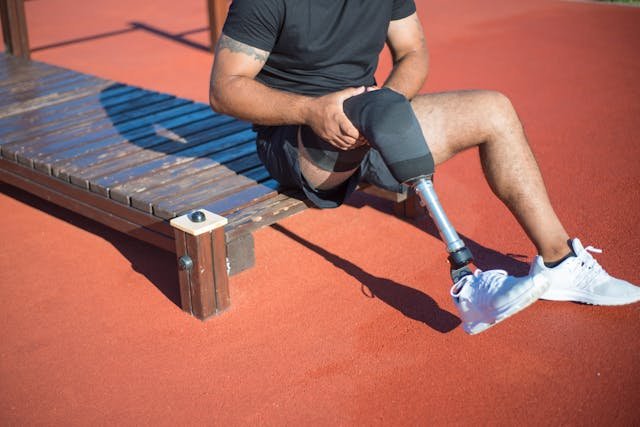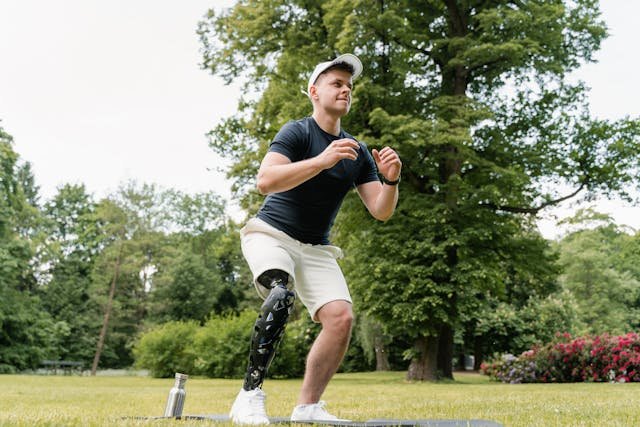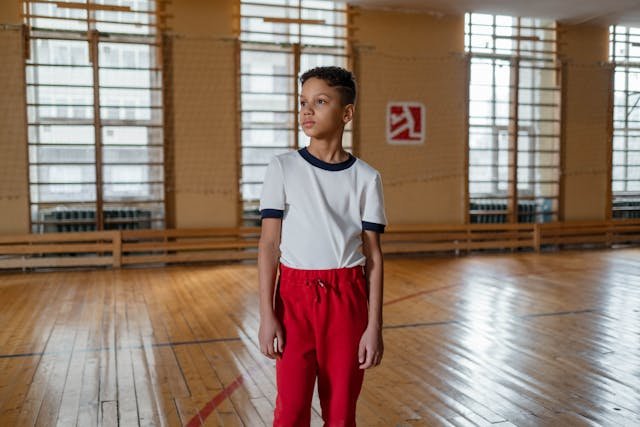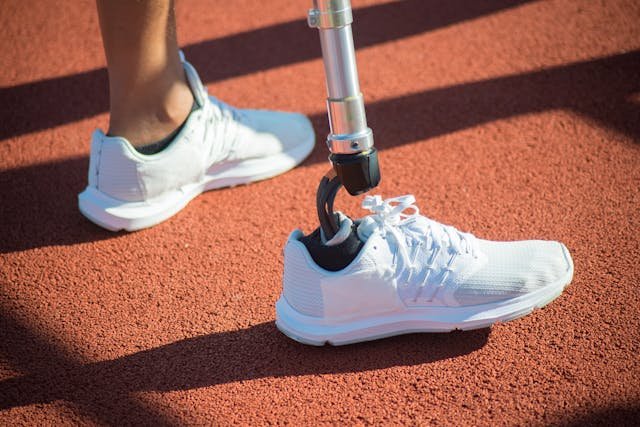Mobility is one of the most important parts of living an independent and confident life after limb loss. Whether someone has an amputation below the knee or above the knee, a well-designed prosthetic can help them move again. But the type of amputation plays a big role in how that mobility feels, works, and changes daily life.
This article explains the key differences between mobility in below-knee (also known as transtibial) and above-knee (also known as transfemoral) prosthetics. While both types are designed to support walking, standing, and daily movement, the way they do it—and the experience they offer—can be quite different.
Understanding these differences can help users and caregivers make better decisions, set realistic goals, and know what kind of support and training to expect. At Robobionics, we believe that knowledge leads to better outcomes, and we’re here to guide you through every step.
The Impact of Amputation Level on Movement
The type of amputation—whether below or above the knee—affects how a person moves and how their body adapts.
Why the Knee Joint Changes Everything

The knee plays a key role in walking, standing, and balance. In a below-knee amputation, the knee joint remains intact, which helps the person maintain a more natural walking motion. Because the joint is still functioning, users can control their steps better and move more efficiently, especially on uneven ground.
For above-knee amputees, the entire knee is missing. This changes how the body has to work to walk and balance. The person now depends on a mechanical or computerized knee joint built into the prosthetic. Learning to control that artificial joint takes time, effort, and therapy.
Because the knee is so important in movement, its presence or absence shapes everything—from how the leg swings during a step to how easily someone can stand or turn. It is the biggest reason mobility differs between transtibial and transfemoral users.
Walking Motion and Natural Gait
A natural walking pattern includes a smooth heel-to-toe motion, knee flexion, and hip coordination. Below-knee prosthetic users can maintain much of this pattern. Their real knee allows them to bend, shift weight, and push off during steps. As a result, their gait looks and feels more natural.
Above-knee prosthetic users must learn to walk differently. Without a natural knee, they have to rely on other body parts—mostly the hips—to swing the leg forward. This creates a different gait that can feel stiff at first. Over time, though, the brain adapts, and users develop a smooth rhythm with practice and physical training.
Maintaining balance also depends on this gait. With better control over step length and foot placement, below-knee users find it easier to balance on one leg or stop mid-step. Above-knee users must focus more on timing and coordination with their artificial knee.
Time Required for Adaptation
Learning to walk with a prosthetic takes time, but how long it takes often depends on the level of amputation. Below-knee users usually adapt faster because they are still using their natural knee. They often feel confident walking short distances soon after initial fitting.
Above-knee users go through a longer adjustment period. Mastering the movement of a prosthetic knee takes practice, and the learning curve is steeper. Early training focuses on posture, weight shifting, and coordination. With continued rehab, though, many people reach strong and steady mobility.
Both groups benefit from ongoing therapy and support. Even after years of prosthetic use, changes in body weight or muscle tone can affect gait. Routine checkups and training help maintain good mobility long-term.
Energy, Balance, and Endurance in Daily Life

Mobility is not just about walking—it’s also about how much energy is used, how long someone can move without tiring, and how stable they feel during everyday activities.
How Much Energy Does It Take to Walk?
Walking with a prosthetic requires more effort than walking with two natural legs. But the amount of energy needed changes depending on the level of amputation. Below-knee users tend to use less energy because they still have their knee to help them move efficiently.
The natural knee joint acts like a lever. It helps lift the leg, absorb shock, and push off during walking. This makes each step feel smoother and lighter. With less strain on the hips and core, below-knee users can usually walk longer distances with less fatigue.
Above-knee users need to put in more work. Without a real knee joint, the body has to compensate. Muscles in the hip, core, and back take on more of the load, especially during walking or climbing stairs. This often leads to quicker fatigue unless the user follows a strong rehabilitation program.
Staying Balanced in Different Situations
Balance is key for safe and confident movement. Below-knee users often find it easier to stay balanced because their prosthetic works with their real knee and thigh muscles. This gives them better control when standing, turning, or stepping in tight spaces.
Above-knee users must depend on an artificial knee, which doesn’t always react like a natural joint. It takes more mental focus and physical control to maintain balance, especially when changing directions quickly. Sudden movements or uneven ground may feel less stable at first.
With proper training and the use of advanced prosthetic technology, balance improves significantly. Some artificial knees now adjust automatically to movement, helping users feel more secure during daily tasks.
Fatigue and Long-Term Comfort
Below-knee users generally experience less fatigue because they retain more natural function. Movements are smoother and require less muscle compensation. As a result, they can stand, walk, or move around longer without discomfort.
Above-knee users may tire more quickly, especially in the early stages of use. Managing fatigue becomes part of the daily routine, requiring scheduled breaks or shorter walking sessions. But as strength builds and movement becomes more efficient, endurance improves.
Good socket fit, prosthetic alignment, and regular exercise all contribute to long-term comfort. Both transtibial and transfemoral users can reach high levels of mobility when their prosthetic is well maintained and tailored to their lifestyle.
Movement in Real-World Environments

Daily mobility involves more than flat floors. Stairs, slopes, uneven surfaces, and quick turns test the limits of any prosthetic.
Navigating Stairs and Inclines
Below-knee prosthetic users usually manage stairs and slopes more easily. Since they have their knee, they can bend it naturally to lift the foot and climb. Descending stairs also feels more controlled because the knee can absorb the motion.
Above-knee users face more difficulty on stairs. The artificial knee must lock or unlock at the right moment to allow safe stepping. Going down stairs may require step-over-step technique or relying more heavily on handrails for support.
Specialized knee designs, such as microprocessor knees, can help by sensing the movement and adjusting resistance. With time and training, many transfemoral users become comfortable on stairs and slopes too.
Walking on Uneven Ground
Gravel, grass, sand, and cobbled paths present challenges for all prosthetic users, but especially for those with above-knee prosthetics. Below-knee users benefit from better feedback through their natural knee and thigh, allowing quicker responses to shifts in terrain.
Above-knee users depend more on visual cues and hip control. Without the natural knee, balance becomes more delicate. They need to focus on foot placement and posture to avoid stumbles or falls. This kind of attention takes practice but becomes second nature over time.
With the right prosthetic foot and knee combination, navigating uneven ground becomes much easier. New materials and designs mimic real ankle motion, giving users a smoother experience.
Turning, Pivoting, and Side-Stepping
Turning around or stepping sideways may seem like small movements, but they are essential for daily life—like moving through doorways or responding quickly in a crowd. Below-knee users usually find these actions easier and quicker because their joints respond naturally.
Above-knee users may take longer to perform the same motions. Pivoting requires careful weight shifting and often engages the whole body. Without knee reflexes, users must rely on core stability and upper body awareness to move safely.
Therapy plays a big role in mastering these techniques. With guided training, both groups can become highly mobile and confident in close quarters or dynamic situations.
Sitting, Standing, and Everyday Transitions

Sitting and standing are things we do constantly, and the way a prosthetic supports those movements affects ease and comfort throughout the day.
Sitting Down with Stability
Below-knee users can sit and stand more naturally. Since the knee bends normally, they can lower themselves into a chair without needing to adjust posture or movement too much. The motion is smooth and often doesn’t require extra thought.
Above-knee users may need to shift weight differently before sitting. Some prosthetic knees lock while standing and must unlock before the user can sit down. Learning how and when to do this becomes part of the routine, especially in public places or unfamiliar chairs.
Advanced prosthetic knees with automatic settings help make sitting more natural. These improvements reduce the effort and time needed for each transition, making daily tasks feel less tiring.
Standing Up from a Seated Position
Getting up from a chair or bench depends on leg strength, balance, and joint function. For below-knee users, this process often feels like it did before amputation. They can use their intact thigh and knee to push up and shift weight forward smoothly.
For above-knee users, standing up takes more effort. Without a real knee, they must lean forward more or use their arms to assist. If the prosthetic knee isn’t positioned correctly, the movement can feel unstable. That’s why many users practice techniques in therapy to ensure safety and ease.
Choosing the right prosthetic knee makes a big difference here. Some knees provide resistance during the stand-up motion, helping the user maintain balance and confidence.
Transferring Weight and Reaching
Reaching for something or shifting weight while standing is a small but common part of daily life. Below-knee users can do this more easily since they have more control over their leg position and balance.
Above-knee users must be more careful. Shifting weight too far to one side or reaching forward quickly can affect balance, especially if the knee isn’t fully extended or locked. Many users learn how to adjust their posture to stay safe and steady during these actions.
With practice, even complex movements like bending, twisting, and reaching become manageable. The key is learning how the prosthetic responds and adjusting movements to match.
The Role of Prosthetic Technology in Enhancing Mobility

Modern technology has completely changed how prosthetic limbs work and feel. Whether someone is using a below-knee or above-knee prosthetic, the right technology can improve comfort, control, and movement in ways that were not possible just a few years ago.
Microprocessor-Controlled Knees and Their Benefits
For above-knee prosthetic users, microprocessor-controlled knees have become a major turning point. These high-tech joints have built-in sensors that read how fast the user is walking, what surface they’re on, and how their body is moving. The sensors then adjust the knee resistance in real time to make walking feel smoother and more natural.
This technology helps with balance and stability. When walking downhill or stepping off a curb, the knee slows the motion automatically, reducing the risk of falling. Going uphill feels easier too, because the knee adjusts to support the user’s stride. Over time, these smart knees allow users to move more freely with less fear and more confidence.
The biggest advantage is safety. Many users say that they feel more in control, especially in busy environments. Microprocessor knees react faster than the human brain can, which adds an extra layer of security when moving through the world. This helps users take on more daily activities without needing constant support.
Advanced Feet and Shock Absorption for Transtibial Users
Below-knee users also benefit from newer technologies, especially in prosthetic feet. Modern prosthetic feet are designed to bend, flex, and respond to the ground in a way that mimics a real foot. This helps make walking feel more natural and reduces the impact on joints like the knee and hip.
Some feet come with built-in shock absorbers. These parts reduce the force that travels through the leg when walking or running. They protect the residual limb and make it more comfortable to walk for long hours. With better shock control, users can walk on hard surfaces like concrete without feeling sore or tired quickly.
Dynamic feet also give users more control over their movement. They return energy with each step, helping the user push forward without extra effort. This feature is especially useful for people who want to stay active and mobile throughout the day.
Custom Sockets and 3D Printing for a Better Fit
A prosthetic is only as good as its socket—the part that connects the device to the body. Whether it’s for a below-knee or above-knee prosthetic, a proper socket fit is the foundation of good mobility. It must be snug but not tight, secure but not restrictive.
Today, 3D printing allows sockets to be customized to each user’s exact limb shape. This process is quicker, more accurate, and often more affordable than traditional methods. The result is a better fit, which means less movement inside the socket and fewer skin problems like blisters or pressure sores.
Personalized sockets also improve weight distribution. This helps reduce pain and allows the prosthetic to move as one with the body. With a better fit, users experience smoother walking, better posture, and more confidence—whether they’re new to prosthetics or have been using them for years.
Mobility Goals: Setting the Right Expectations

Mobility isn’t a one-size-fits-all experience. Every user has different goals, strengths, and challenges. Choosing the right prosthetic starts with understanding your personal needs and working toward achievable goals.
Understanding Short-Term vs Long-Term Mobility
Right after getting a prosthetic, most users want to stand, walk, and move as soon as possible. These are short-term goals that help build confidence and start the rehabilitation process. For below-knee users, these goals are often reached more quickly because the learning curve is shorter.
Above-knee users may take more time to reach the same short-term goals. Early steps may feel unsteady, but with practice, users begin to walk more confidently. Physical therapy focuses on balance, muscle control, and learning how to move in sync with the prosthetic knee.
Long-term mobility goals often include walking long distances, climbing stairs, or even running. These goals are reachable with regular training, good prosthetic maintenance, and ongoing support. Many users—even with above-knee prosthetics—return to highly active lifestyles and sports once they master the basics.
Matching Prosthetic Features to Your Lifestyle
Choosing a prosthetic is not just about the limb—it’s about your life. If you enjoy walking daily, you’ll need a prosthetic that supports endurance. If you work on your feet, you’ll need something built for long hours. If you love sports, you’ll need a different setup entirely.
Below-knee users can often rely on standard prosthetics with energy-return feet for walking and light activity. For more demanding routines, a dynamic foot with added shock absorption may be needed. The goal is to match the features of the prosthetic to the way the user lives, not the other way around.
Above-knee users have more to consider, especially with the knee joint. Some knees are better for casual walking, while others are designed for running, climbing, or heavy physical activity. The more your prosthetic matches your life, the easier it is to reach your goals and stay motivated.
The Importance of Regular Reviews and Adjustments
Mobility changes over time. What works well in the first year may need adjustments later. Muscles get stronger, movement becomes more confident, and sometimes the shape of the residual limb changes too. This makes regular reviews important for maintaining comfort and mobility.
At Robobionics, we recommend follow-ups every few months, especially during the first year. These visits help us spot any issues early—whether it’s socket discomfort, gait imbalances, or wear and tear in the prosthetic components.
As users become more active, their goals may also change. A prosthetic designed for short walks might need an upgrade to handle jogging or sports. By checking in regularly, users can stay ahead of these changes and keep their mobility strong and steady.
Final Thoughts on Mobility Differences
Mobility is deeply personal, and every prosthetic user has a unique journey. But understanding the main differences between below-knee and above-knee prosthetics can help set expectations, goals, and the right plan for long-term success.
Below-knee users typically enjoy faster adaptation, smoother gait, and less fatigue. Above-knee users face more challenges early on but can achieve excellent mobility with modern technology and strong rehabilitation.
At Robobionics, we are committed to helping every individual regain independence. Whether you need a transtibial or transfemoral prosthetic, we offer advanced solutions, personalized fittings, and gamified home-based rehab to support your recovery every step of the way.
Book a free demo of your ideal prosthetic with Robobionics today—and take your first step toward a more mobile life.



